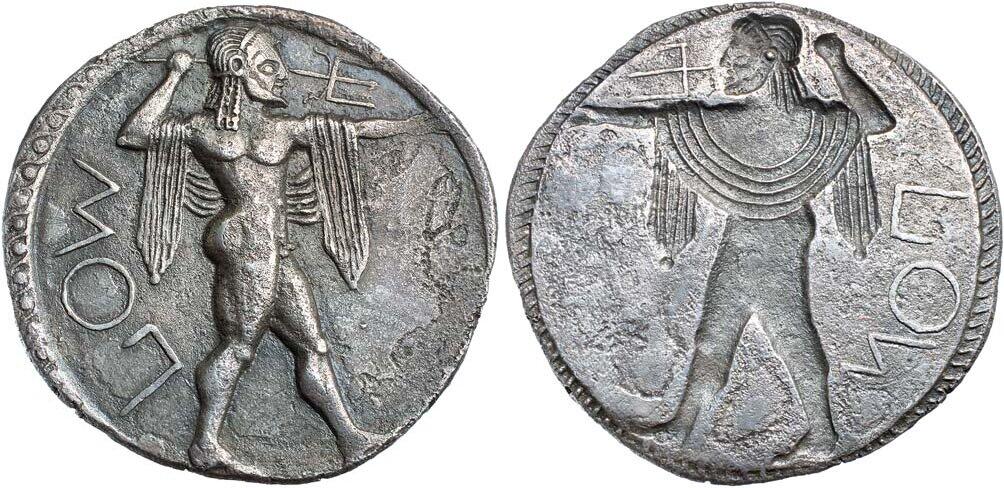S 303 - Poseidonia, silver, staters (530-490 BCE)
From SILVER
530 BCE - 475 BCE Silver 8,918 kg
Description
| ObverseInscription or printing placed on the obverse.: | ΠΟΣ, ΠΟΣEI ou ΠΟΣEIΔΑΝΙ (Greek).Poseidon, naked but for chlamys over shoulder, advancing right brandishing trident in right hand and extending left arm, **POS* retrograde to left, dotted border |
| ReverseInscription or printing placed on the reverse.: | Poseidon striding left as on obverse, reversed and incuse |
Mint and issuing power
| MintIdentifies the place of manufacture or issue of a numismatic object.: | Poseidonia | Ancient regionAncient region.: | Lucania | Modern countryModern country: Italy | AuthorityIdentifies the issuing power. The authority can be "pretended" when the name or the portrait of X is on the coin but he/she was not the issuing power. It can also be "uncertain" when there is no mention of X on the coin but he/she was the issuing power according to the historical sources: |
Chronology
| FromIdentifies the initial date in a range assigned in a numismatic context. | 530 BCE | toIdentifies the final date in a range assigned in a numismatic context.. | 475 BCE | PeriodTime period of the numismatic object.: Archaic until 480 BC |
Physical description
| MetalThe physical material (usually metal) from which an object is made.: | Silver |
Median weightMedian of the weights of numismatic objects (in grams). in grams | 7.90 | DenominationTerm indicating the value of a numismatic object. Examples: tetradrachm, chalkous, denarius.: | stater |
StandardStandard.: |
Image

S 303 - Poseidonia, silver, staters (530-490 BCE).jpg [1]
References
| Die study referencePublication of the study: | Brousseau 20091Brousseau 2009, p. 271-298 (O1-O54) | ||
| Coin series referenceReference to coin series study: | |||
Obverse dies distribution
| FrequencyFrequency of specimen in distribution. ᵖ | Number of obversesNumber of obverse dies. ᵖ (o) | % (o) | Number of coinsNumber of coins. (n) | % (n) | Die nameName(s) of the die(s). |
| 1 | 11 | 21.15 | 11 | 3.7 | 1;6;7;9;16;17;18;34;45;49;54 |
| 2 | 5 | 9.62 | 10 | 3.37 | 2;14;40;50;52 |
| 3 | 6 | 11.54 | 18 | 6.06 | 11;19;39;44;47;48 |
| 4 | 4 | 7.69 | 16 | 5.39 | 5;20;23;37 |
| 5 | 6 | 11.54 | 30 | 10.1 | 3;8;22;32;41;46 |
| 6 | 1 | 1.92 | 6 | 2.02 | 42 |
| 7 | 4 | 7.69 | 28 | 9.43 | 4;10;21;26 |
| 8 | 3 | 5.77 | 24 | 8.08 | 13;30;43 |
| 9 | 3 | 5.77 | 27 | 9.09 | 25;36;38 |
| 10 | 1 | 1.92 | 10 | 3.37 | 53 |
| 11 | 1 | 1.92 | 11 | 3.7 | 12 |
| 12 | 2 | 3.85 | 24 | 8.08 | 28;33 |
| 13 | 1 | 1.92 | 13 | 4.38 | 27 |
| 15 | 1 | 1.92 | 15 | 5.05 | 24 |
| 16 | 2 | 3.85 | 32 | 10.77 | 31;35 |
| 22 | 1 | 1.92 | 22 | 7.41 | 29 |
| Total | 52 of 52 | 99.99 | 297 of 297 | 100 |
Reverse dies distribution
no distribution is available
Quantification
| Number of obversesNumber of obverse dies. ᵖ (o) | 52 | Number of singletons (o1)The number of singleton coins. ᵖ | 11 |
| Number of reverse diesNumber of reverse dies. (r) | 88 | Number of coinsNumber of coins. (n) | 297 |
| Coins per obverse dieNumber of coins per obverse die. (n/o) | 5.71 | Coins per reverse dieNumber of coins per reverse die. (n/r) | 3.38 |
| Reverse per obverse ratioRatio of obverse dies divided by reverse dies. (r/o) | 1.69 | Percentage of singletons (o1)number of coins (n) divided by the number of singletons (o1) ᵖ | 21.15 % |
| Original number of dies (O) (Carter 1983 formula)The estimation of the number of coins according to Carter 1983 ᵖ | 56.44 | Coins struck if 20,000 as average productivity per dieCoins made if the average productivity for obverses (according to Carter) is 20,000. ᵖ | 1,128,800 |
| Original number of dies (O) (Esty 2011 formula)The estimation of the number of coins according to the singleton formula in Esty 2011 ᵖ (O) | 63.04 | Survival rate if 20,000 as average productivity per dieSurvival rate if average productivity is 20,000. ᵖ | 0.00026 |
| Coverage (o = % of O) (Esty 1984 formula)Esty 1984 - coverage (% of O) ᵖ (o = % of O) | 96.3% | Die productivity if survival rate 1/2,000Average productivity if survival rate is 1/2,000. ᵖ | 10,524.45 |
| Weight of silver (in kg) if 20,000 coins per die (O = Carter formula)Carter 1983 * Median weight * 20000 (*10 if gold or electrum) ᵖ | 8,918 kg <br /> 8,918 kg | Die productivity if survival rate 1/5,000Average productivity if survival rate is 1/5,000. ᵖ | 26,311.13 |
Remarks